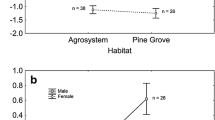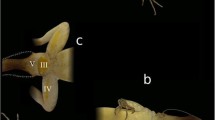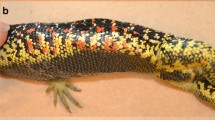Abstract
Multiple traits may either signal different characteristics of a male or be redundant. These multiple signals may convey different messages if they are intended for different receivers (e.g., male or females) that have different interests. We examined the functions of multiple colorful visual traits of male Schreiber’s green lizard (Lacerta schreiberi). Results showed that interindividual variation in the characteristics of coloration of males can be related to variation in morphology, health state, dominance status, and pairing status, but that different relationships were found for each color signal. For example, dominant males had brighter “blue” throat and with higher values of ultraviolet (UV) and bluish coloration and darker and greenish dorsal coloration than subordinate males. Health state was also reflected in coloration; males with a higher immune response had “blue” throats with lower amounts of UV coloration, but had “yellow” chests with higher amounts of UV coloration. Males found guarding females also differed in coloration from males found alone. These data suggest that characteristics of coloration of the different multiple signals may reveal different messages for different receivers, either male or female conspecifics. The development of the different signals, based on different morphological and physiological mechanisms and trade-offs, may allow signal reliability of multiple colorful traits in different social contexts.





Similar content being viewed by others
References
Anderholm S, Olsson M, Wapstra E, Ryberg K (2004) Fit and fat from enlarged badges: a field experiment on male sand lizards. Proc R Soc Lond B (Suppl) 271:142–144
Andersson M (1994) Sexual selection. Princeton University Press, Princeton
Anderson RA, Vitt LJ (1990) Sexual selection versus alternative causes of sexual dimorphism in teiid lizards. Oecologia 84:145–157
Andersson S, Pryke SR, Ornborg J, Lawes MJ, Andersson M (2002) Multiple receivers, multiple ornaments, and a tradeoff between agonistic and epigamic signaling in a widowbird. Am Nat 160:683–691
Baird TA, Fox SF, McCoy JK (1997) Population differences in the roles of size and coloration in intra- and intersexual selection in the collared lizard, Crotaphytus collaris: influence of habitat and social organization. Behav Ecol 8:506–517
Baird TA, Hranitz JM, Timanus DK, Schwartz AM (2007) Behavioral attributes influence annual mating success more than morphological traits in male collared lizards. Behav Ecol 18:1146–1154
Belliure J, Smith L, Sorci G (2004) Effect of testosterone on T cell-mediated immunity in two species of Mediterranean Lacertid lizards. J Exp Zool A 301:411–418
Berglund A, Bisazza A, Pilastro A (1996) Armaments and ornaments: an evolutionary explanation of traits of dual utility. Biol J Linn Soc 58:385–399
Blount JD, Metcalfe NB, Birkhead TR, Surai PF (2003) Carotenoid modulation of immune function and sexual attractiveness in zebra finches. Science 300:125–127
Bonnet X, Naulleau G (1994) A body condition index (BCI) in snakes to study reproduction. C R Acad Sci Ser III Sci Vie 317:34–41
Calisi RM, Hews DK (2007) Steroid correlates of multiple color traits in the spiny lizard, Sceloporus pyrocephalus. J Comp Physiol B 177:641–654
Cooper WE, Greenberg N (1992) Reptilian coloration and behavior. In: Gans C, Crews D (eds) Biology of the Reptilia, vol 18. University of Chicago Press, Chicago, pp 298–422
Cuthill IC, Bennett ATD, Partridge JC, Maier EJ (1999) Plumage reflectance and the objective assessment of avian sexual dichromatism. Am Nat 153:183–200
Doucet S, Montgomerie R (2003) Multiple sexual ornaments in satin bowerbirds: ultraviolet plumage and bowers signal different aspects of male quality. Behav Ecol 14:503–509
Ellingson JM, Fleishman LJ, Loew ER (1995) Visual pigments and spectral sensitivity of the diurnal gecko Gonatodes albogularis. J Comp Physiol A 177:559–567
Endler JA (1990) On the measurement and classification of colour in studies of animal colour patterns. Biol J Linn Soc 41:315–352
Faivre B, Grégoire A, Préault M, Cézilly F, Sorci G (2003) Immune activation rapidly mirrored in a carotenoid-based secondary sexual trait. Science 300:103
Fitze PS, Cote J, Martínez-Rica JP, Clobert J (2008) Determinants of male fitness: disentangling intra- and inter-sexual selection. J Evol Biol 21:246–255
Fleishman LJ, Loew ER, Leal M (1993) Ultraviolet vision in lizards. Nature 365:397
Fleishman LJ, Bowman M, Saunders D, Miller WE, Rury MJ, Loew ER (1997) The visual ecology of Puerto Rican anoline lizards: habitat light and spectral sensitivity. J Comp Physiol A 181:446–460
Fox SF, Rose E, Myers R (1981) Dominance and the acquisition of superior home ranges in the lizard Uta stansburiana. Ecology 62:888–893
Fox SF, Rotsker MA (1982) Social costs of tail loss in Uta stansburiana. Science 218:692–693
Grafen A (1990) Biological signals as handicaps. J Theor Biol 144:517–546
Grill CP, Rush VN (2000) Analysing spectral data: comparison and application of two techniques. Biol J Linn Soc 69:121–138
Hamilton PS, Sullivan BK (2005) Female mate attraction in ornate tree lizards, Urosaurus omatus: a multivariate analysis. Anim Behav 69:219–224
Herrel A, Spithoven L, Van Damme R, De Vree F (1999) Sexual dimorphism of head size in Gallotia galloti: testing the niche divergence hypothesis by functional analyses. Funct Ecol 13:289–297
Hews DK (1990) Examining hypotheses generated by field measures of sexual selection on male lizards, Uta palmeri. Evolution 44:1956–1966
Hofmann S, Henle K (2006) Male reproductive success and intrasexual selection in the common lizard determined by DNA-microsatellites. J Herpetol 40:1–6
Huyghe K, Vanhooydonck B, Scheers H, Molina-Borja M, Van Damme R (2005) Morphology, performance and fighting capacity in male lizards, Gallotia galloti. Funct Ecol 19:800–807
Iwasa Y, Pomiankowski A (1994) The evolution of mate preferences for multiple sexual ornaments. Evolution 48:853–867
Johnstone RA (1995) Honest advertisement of multiple qualities using multiple signals. J Theor Biol 177:87–94
Klukowski M, Nelson C (2001) Ectoparasite loads in free-ranging northern fence lizards, Sceloporus undulatus hyacinthinus: effects of testosterone and sex. Behav Ecol Sociobiol 49:289–295
Kwiatkowski MA, Sullivan BK (2002) Geographic variation in sexual selection among populations of an Iguanid lizard, Sauromalus obesus (=ater). Evolution 56:2039–3051
Lappin AK, Husak JF (2005) Weapon performance, not size, determines mating success and potential reproductive output in the collared lizard (Crotaphytus collaris). Am Nat 166:426–436
Lappin AK, Hamilton PS, Sullivan BK (2006) Bite-force performance and head shape in a sexually dimorphic crevice-dwelling lizard, the common chuckwalla [Sauromalus ater (= obesus)]. Biol J Linn Soc 88:215–222
Lailvaux SP, Irschick DI (2006) No evidence for female association with high-performance males in the Green Anole lizard Anolis carolinensis. Ethology 112:707–715
LeBas NR (2001) Microsatellite determination of male reproductive success in a natural population of the territorial ornate dragon lizard, Ctenophorus ornatus. Mol Ecol 10:193–203
Loew ER, Fleishman LJ, Foster RG, Provencio I (2002) Visual pigments and oil droplets in diurnal lizards: a comparative study of Caribbean anoles. J Exp Biol 205:927–938
López P, Martín J (2001) Fighting rules and rival recognition reduce costs of aggression in male lizards, Podarcis hispanica. Behav Ecol Sociobiol 49:111–116
López P, Muñoz A, Martín J (2002) Symmetry, male dominance and female mate preferences in the Iberian rock lizard, Lacerta monticola. Behav Ecol Sociobiol 52:342–347
López P, Gabirot M, Martín J (2009) Immune challenge affects sexual coloration of male Iberian wall lizards. J Exp Zool A Ecol Genet Physiol 311:96–104
Loyau A, Saint Jalme M, Cagniant C, Sorci G (2005) Multiple sexual advertisements honestly reflect health status in peacocks (Pavo cristatus). Behav Ecol Sociobiol 58:552–557
Macedonia JM, James S, Wittle LW, Clark DL (2000) Skin pigments and coloration in the Jamaican radiation of Anolis lizards. J Herpetol 34:99–109
Marco A (1994) Autoecología y biología reproductora del lagarto verdinegro (Lacerta schreiberi, Bedriaga, 1878) en una población de media montaña en la Sierra de Béjar (Salamanca). Ph.D. thesis, Univ Salamanca, Spain
Marco A (1995) Edad de adquisición de madurez sexual y variación interanual del tamaño corporal en una población del lagarto Lacerta schreiberi. Rev Esp Herpetol 9:103–111
Marco A (1996) Sedentarismo, áreas de campeo y selección de microhábitats en el lagarto verdinegro Lacerta schreiberi. Doñana Acta Vertebr 23:45–61
Marco A (2002) Lacerta schreiberi Bedriaga, 1878. Lagarto verdinegro. In: Pleguezuelos JM, Márquez R, Lizana M (eds) Atlas y libro rojo de los anfibios y reptiles de España. Dirección General de Conservación de la Naturaleza-Asociación Herpetológica Española, Madrid, pp 232–234
Marco A, Pérez-Mellado V (1990) Donnes sur la reproduction de Lacerta schreiberi (Sauria: Lacertidae) au Systeme Central (Espagne). Bull Soc Fr Herpetol 50:1–8
Marco A, Pérez-Mellado V (1999) Mate guarding, intrasexual competition and mating success in males of the non-territorial lizard Lacerta schreiberi. Ethol Ecol Evol 11:279–286
Martin LB II, Han P, Lewittes J, Kuhlman JR, Klasing KC, Wikelski M (2006) Phytohemagglutinin-induced skin swelling in birds: histological support for a classic immunoecological technique. Funct Ecol 20:290–299
Martín J, Forsman A (1999) Social costs and development of nuptial coloration in male Psammodromus algirus lizards: an experiment. Behav Ecol 10:396–400
Martín J, Salvador A (1993) Tail loss reduces mating success in the Iberian rock-lizard. Behav Ecol Sociobiol 32:185–189
Martín J, Amo L, López P (2008) Parasites and health affect multiple sexual signals in male common wall lizards, Podarcis muralis. Naturwissenschaften 95:293–300
Meyers JJ, Irschick DJ, Vanhooydonck B, Herrel A (2006) Divergent roles for multiple sexual signals in a polygynous lizard. Funct Ecol 20:709–716
Møller AP, Pomiankowski A (1993) Why have birds got multiple sexual ornaments? Behav Ecol Sociobiol 32:167–176
Montgomerie R (2006) Analyzing colors. In: Hill GE, McGraw KJ (eds) Bird coloration, vol 1. Mechanisms and measurements. Harvard University Press, Cambridge, MA, pp 90–147
Moore MC, Lindzey J (1992) The physiological basis of sexual behavior in male reptiles. In: Gans C, Crews D (eds) Biology of the Reptilia, vol 8. University of Chicago Press, Chicago, pp 70–113
Olsson M (1994a) Why are sand lizard males (Lacerta agilis) not equally green? Behav Ecol Sociobiol 35:169–173
Olsson M (1994b) Rival recognition affects male contest behavior in sand lizards (Lacerta agilis). Behav Ecol Sociobiol 35:249–252
Olsson M, Shine R (2000) Ownership influences the outcome of male-male contests in the scincid lizard, Niveoscincus microlepidotus. Behav Ecol 11:587–590
Olsson M, Wapstra E, Madsen T, Silverin B (2000) Testosterone, ticks, and travels: a test of the immunocompetence-handicap hypothesis in free-ranging sand lizards. Proc R Soc Lond B 267:2339–2343
Pérez-Mellado V (1998) Lacerta schreiberi (Bedriaga, 1878). In: Salvador A (ed) Reptiles, Fauna Ibérica, vol 10. Museo Nacional de Ciencias Naturales, CSIC, Madrid, pp 218–227
Pryke SR, Andersson S, Lawes MJ (2001) Sexual selection of multiple handicaps in red-collared widowbirds: female choice of tail length but not carotenoid display. Evolution 55:1452–1463
Qvarnströn A, Forsgren E (1998) Should females prefer dominant males? Trends Ecol Evol 13:498–501
Quinn VS, Hews DK (2003) Positive relationship between abdominal coloration and dermal melanin density in phrynosomatid lizards. Copeia 2003:858–864
Rohwer S (1982) The evolution of reliable and unreliable badges of fighting ability. Am Zool 22:531–546
Rowe C (1999) Receiver psychology and the evolution of multicomponent signals. Anim Behav 58:921–931
Salvador A (1988) Selección de microhábitat del lagarto verdinegro (Lacerta schreiberi) (Sauria, Lacertidae). Amphib–Reptil 9:265–276
Salvador A, Veiga P, Martin J, Lopez P, Abelenda M, Puerta M (1996a) The cost of producing a sexual signal: testosterone increases the susceptibility on male lizards to ectoparasitic infestation. Behav Ecol 7:145–150
Salvador A, Martín J, López P, Veiga P (1996b) Long-term effects of tail loss on home range size and access to females in male lizards (Psammodromus algirus). Copeia 1996:208–209
Salvador A, Díaz JA, Veiga JP, Bloor P, Brown RP (2008) Correlates of reproductive success in male lizards of the alpine species Iberolacerta cyreni. Behav Ecol 19:169–176
Schall JJ, Staats CM (1997) Parasites and the evolution of extravagant male characters: Anolis lizards on Caribbean islands as a test of the Hamilton–Zuk hypothesis. Oecologia 111:543–548
Scheiner MS (2001) MANOVA: multiple response variables and multispecies interactions. In: Scheiner MS, Gurevitch J (eds) Design and analysis of ecological experiments, 2nd edn. Oxford University Press, New York, pp 99–115
Stapley J (2008) Female mountain log skinks are more likely to mate with males that court more, not males that are dominant. Anim Behav 76:529–538
Sinervo B, Miles DB, Frankino A, Klukowski M, DeNardo DF (2000) Testosterone, endurance, and Darwinian fitness: natural and sexual selection on the physiological bases of alternative male behaviors in side-blotched lizards. Horm Behav 38:222–233
Smits JE, Bortolotti GR, Tella JL (1999) Simplifying the phytohaemagglutinin skin-testing technique in studies of avian immunocompetence. Funct Ecol 13:567–572
Stapley J, Whiting MJ (2006) Ultraviolet signals fighting ability in a lizard. Biol Lett 2:169–172
Sullivan MS (1994) Mate choice as an information gathering process under time constraint: implications for behaviour and signal design. Anim Behav 47:141–151
Tarof SA, Dunn PO, Whittingham LA (2005) Dual functions of a melanin-based ornament in the common yellowthroat. Proc R Soc Lond B 272:1121–1127
Tella JL, Lemus JA, Carrete M, Blanco G (2008) The PHA test reflects acquired T-cell mediated immunocompetence in birds. PloS ONE 3:e3295
Thompson CW, Moore MC (1991) Throat colour reliably signals status in male tree lizards Urosaurus ornatus. Anim Behav 42:298–442
Uller T, Olsson M (2003) Prenatal exposure to testosterone increases ectoparasite susceptibility in the common lizard (Lacerta vivipara). Proc R Soc Lond B 270:1867–1870
Václav R, Prokop P, Fekiac V (2007) Expression of breeding coloration in European Green Lizards (Lacerta viridis): variation with morphology and tick infestation. Can J Zool 85:1199–1206
Whiting MJ, Nagy KA, Bateman PW (2003) Evolution and maintenance of social status-signalling badges: experimental manipulations in lizards. In: Fox SF, McCoy JK, Baird TA (eds) Lizard social behavior. John Hopkins University Press, Maryland, pp 47–82
Whiting MJ, Stuart-Fox D, O’Connor D, Firth D, Bennett NC, Blomberg SP (2006) Ultraviolet signals ultra-aggression in a lizard. Anim Behav 72:353–363
Wong BBM, Candolin U (2005) How is female mate choice affected by male competition? Biol Rev 80:559–571
Zucker N (1994) A dual status-signalling system: a matter of redundancy or differing roles? Anim Behav 47:15–22
Acknowledgments
We thank W.E. Cooper and three anonymous reviewers for their helpful comments and “El Ventorrillo” MNCN Field Station for the use of their facilities. Financial support was provided by the projects MEC-CGL2005-00391/BOS and MCI-CGL2008-02119/BOS and by a Hungarian–Spanish Intergovernmental S&T Cooperation Programme (Acción Integrada, HH2006-0024) funded by the Spanish Ministerio de Educación y Ciencia and the Hungarian Science and Technology Foundation. Experiments were performed under license from the “Comunidad de Madrid” Environmental Agency.
Author information
Authors and Affiliations
Corresponding author
Additional information
Communicated by W. Cooper
Rights and permissions
About this article
Cite this article
Martín, J., López, P. Multiple color signals may reveal multiple messages in male Schreiber’s green lizards, Lacerta schreiberi . Behav Ecol Sociobiol 63, 1743–1755 (2009). https://doi.org/10.1007/s00265-009-0794-6
Received:
Revised:
Accepted:
Published:
Issue Date:
DOI: https://doi.org/10.1007/s00265-009-0794-6




